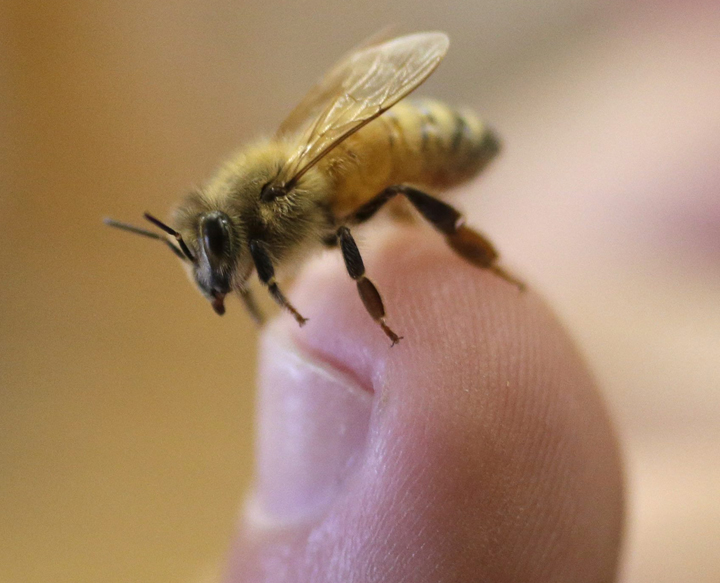An international symposium on the use of neonicotinoids — the pesticide believed to be responsible for the widespread loss of bees in Ontario and Quebec, as well as Europe — was held at York University on Tuesday with a focus on the effects on pollinators and integrated pest management.

READ MORE: Silence of the bees—‘It has to stop. It just has to stop.’
Another concerning issue discussed — one that has yet to be fully understood — is the effects it has had on humans.
The symposium was a gathering of scientists from the international Task Force on Systemic Pesticides, as well as the David Suzuki Foundation and the Canadian Association of Physicians for the Environment (CAPE).
Neonicotinoids, also called NNIs or neonics, are the most widely used pesticide around the world. It consists of a group of pesticides that target the neuron pathway found most in insects rather than in vertebrates. However, studies on vertebrates such as mice, rats and fish have found that there is some level of toxicity, which varies on the specific type of neonic used.
A study found that one such neonic, called imidacloprid, was toxic (which is referred to as LD50) in many birds as well as fish. (Another similar insecticide called fipronil, which is similar to neonics, was also as toxic.) Sub-lethal levels, meaning that it didn’t result in death, but neurological effects such as reduced learning and cognitive abilities, was also found in birds and fish exposed to those two pesticides as well as in another neonic called clothianidin.
Neonics came into use in the 1990s, but their use skyrocketed within a decade. Today, almost 100 per cent of corn seeds are treated with it here in Canada.
The alarm bells for neonics reached a peak in 2014 in Canada when beekeepers in Ontario and Quebec noticed that their bees were dying off at an alarming rate. Health Canada’s Pest Management Regulatory Agency (PMRA) visited some southern Ontario beekeepers and collected samples of their dead bees. They found that 70 per cent tested positive for neonics.
WATCH: 16X9’s Flight of the Bees
Human effects
Neonics is water-soluble: it is absorbed and carried throughout a plant, protecting it against pests. The catch is only 2 to 30 per cent is taken in by the plant. The remaining amount is taken in by the soil which can then spread to non-targeted organisms, like butterflies, bees, fish — and recent evidence suggests even humans.
Kumiko Tairo, who spoke at the symposium in Toronto, has studied the effects of NNIs on humans in Gunma Prefecture, near Tokyo. In 2004 and 2005, 78 and 63 patients respectively — young and old — began experiencing symptoms such as headaches and memory loss. When examined, many had abnormal ECGs. Then, in 2006 and 2007, there were 1,111 more patients with similar symptoms. The most prevalent symptom in all cases was a headache, followed by shoulder and chest pain.
Urinalysis detected high doses of neonics. Brain scans revealed that the mid-brain was clearly affected.
Tairo and her team found that the likely culprit was tea leaves which were affected by pesticide leaching into the soil. Aerial spraying also put residents at risk of increased exposure due to drift.
“Now we are facing the increasingly dangerous presence of neonics in humans,” Tairo said on Tuesday.
“We speculate that nenoics are retained in the human body, and continuous use may pollute human tissue.”
All patients eventually recovered.
While no such human studies have been conducted here in Canada, Glenn Murray, Ontario’s Minister of the Environment and Climate Change, who also addressed the symposium, said there isn’t enough evidence on the extended use of NNIs in our environment.
WATCH: Task Force on Systemic Pesticides
“No one has a clue of long-term use,” he said.
The problem, he acknowledged, is that neonics were only conditionally approved in Canada but have been widely used without much solid, independent research done on the consequences or the pervasiveness in the environment.
As a result, the Ontario government became the first province to restrict the widespread use of NNIs. It plans on reducing the number of hectares planted with neonic-treated corn and soybean seeds by 80 per cent by 2017.
Although most Canadians live in large urban centres and don’t need to worry about neonics being sprayed on corn, they can be found in a multitude of other sources, including at your local garden centres.
READ MORE: Garden centre flowers test positive for pesticide harmful to bees—study
A 2014 study by Friends of the Earth found that 51 per cent of plants tested from commercial nurseries tested positive with neonic residues.
Neonics are also used on golf courses and are even present in flea and tick treatments for pets, though in low doses.
More concerning is that neonics — a result of use on farms — are making their way into waterways.
The cases in Gunma are not the only evidence that neonics are harmful to humans. In 2013, an Indian farmer who was spraying his field with a NNI pesticide was admitted to the hospital with symptoms that included nausea, vomiting and muscle twitching. He also became agitated and delirious. The farmer later recovered.
The European Food Safety Authority has also concluded that neonics could affect the human nervous system.
Though neonics are targeted at invertebrates, gathering evidence suggests they have far-reaching effects. And how that translates to humans has yet to be fully understood.
“More studies need to be done,” Tairo said.



Comments